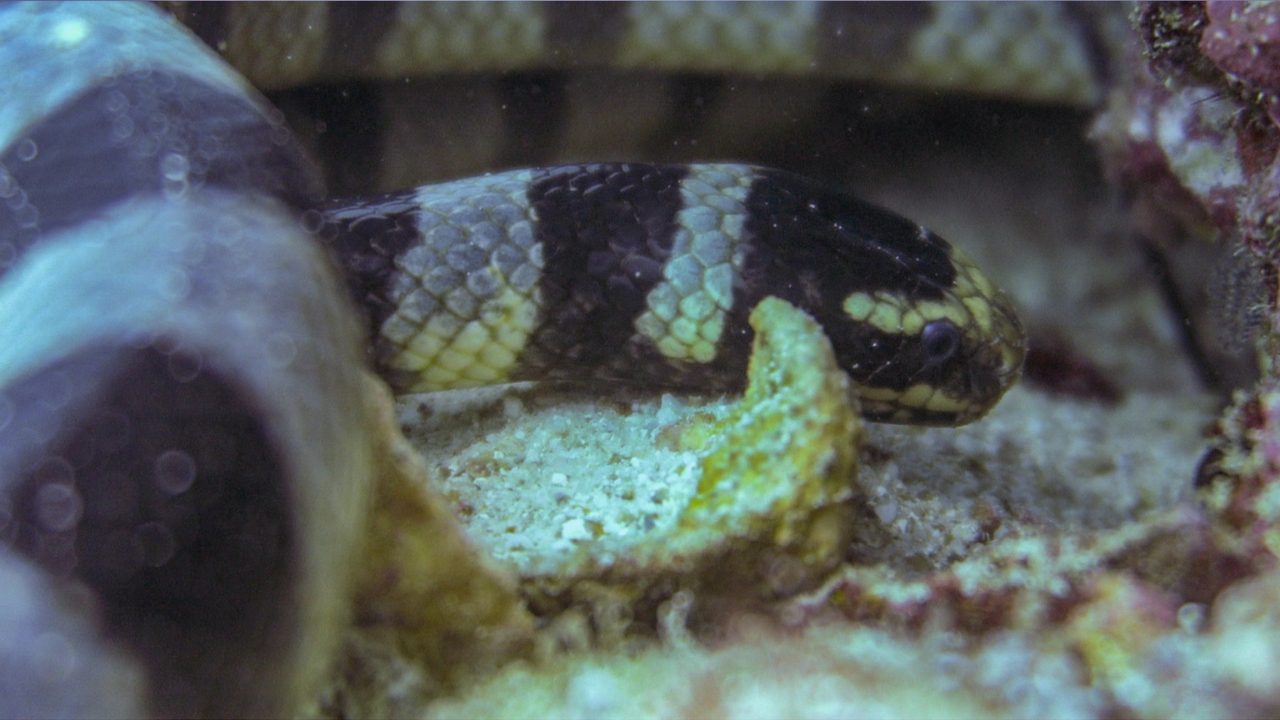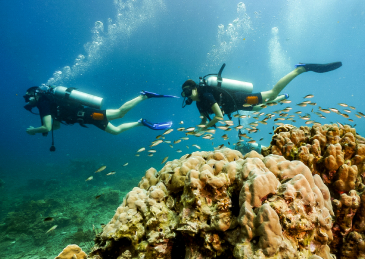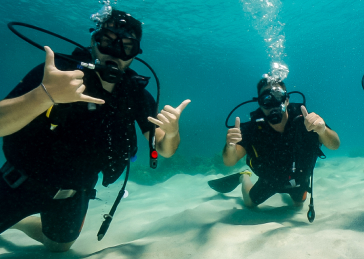Modified 9th June 2025
Banded Sea Krait Koh Tao: Complete Guide to Spotting These Marine Snakes
Spotting a Banded Sea Krait Koh Tao during your diving adventure represents one of the most exciting marine encounters available in Thai waters. These remarkable amphibious snakes, scientifically known as Laticauda colubrina, combine stunning visual appeal with fascinating behavior patterns that make them a photographer’s dream and a naturalist’s delight.
Understanding where to find these creatures, how to observe them safely, and their importance to Koh Tao’s marine ecosystem enhances every diving experience while contributing to marine conservation awareness.

- Black and silvery-blue banded pattern
- White head with black cap marking
- Paddle-shaped tail for swimming
- Females can exceed 2 meters in length
- Males typically reach 1 meter
- Specialized lungs for extended underwater periods
- Amphibious lifestyle capability
- Excellent navigation abilities
- Powerful neurotoxic venom for hunting
- Enhanced sense of smell for prey detection
- Primarily nocturnal hunters
- Return to same nesting sites annually
- Come ashore to rest and mate
- Non-aggressive toward humans
- Excellent swimmers and climbers
Best Locations for Banded Sea Krait Koh Tao Sightings
Prime Diving Sites
While Banded Sea Krait Koh Tao sightings are considered rare, certain dive sites offer better opportunities for encounters. These locations provide the coral reef environments and prey abundance that attract these remarkable snakes.
Shallow coral gardens perfect for spotting kraits hunting among the reefs. High biodiversity attracts their preferred prey.
Rocky crevices and coral formations provide ideal habitat. Often visited during morning and afternoon dives.
Deep coral pinnacles with excellent fish populations. Kraits often hunt in the surrounding sandy areas.
Twin rock formations create diverse microhabitats. Excellent visibility increases spotting chances.

When to Spot Banded Sea Krait Koh Tao
Timing plays a crucial role in successful Banded Sea Krait Koh Tao encounters. These snakes are most active during specific conditions and times, making strategic dive planning essential for wildlife enthusiasts. Understanding the best diving seasons significantly increases your chances of encounters.
| Factor | Optimal Conditions | Why This Matters |
|---|---|---|
| Season | March to September | Calm seas and high visibility |
| Time of Day | Early morning or late afternoon | Increased snake activity periods |
| Weather | Clear skies, minimal wind | Better underwater visibility |
| Tide | Incoming or high tide | More active fish movement |
| Moon Phase | New moon periods | Enhanced nocturnal hunting behavior |
Safety Guidelines for Banded Sea Krait Koh Tao Encounters
While Banded Sea Krait Koh Tao encounters are generally safe, these snakes possess potent neurotoxic venom. Following proper safety protocols ensures enjoyable and risk-free observations.
Safe Observation Practices
- Maintain Distance: Keep at least 2-3 meters away from any sea krait
- No Sudden Movements: Move slowly and deliberately to avoid startling the snake
- Never Touch: Resist any urge to touch or handle the krait
- Buddy System: Always dive with a partner and communicate sightings
- Photography Ethics: Use natural light and avoid flash photography
- Emergency Procedures: Know emergency ascent and medical protocols
What to Do During an Encounter
- Stop all movement and signal your dive buddy
- Maintain neutral buoyancy and observe from distance
- Allow the krait to move freely without blocking its path
- Take photos only if the snake appears undisturbed
- Never corner or chase the animal
- Continue your dive normally after the encounter
Ecological Importance of Banded Sea Krait Koh Tao
The presence of Banded Sea Krait Koh Tao serves as an important indicator of reef health and biodiversity. These apex predators play crucial roles in maintaining marine ecosystem balance while supporting the complex food webs that make Koh Tao’s marine environment so special.
Ecosystem Role
- Population Control: Regulate eel and small fish populations
- Biodiversity Indicator: Their presence signals healthy reef ecosystems
- Food Web Balance: Serve as both predator and prey species
- Habitat Health: Require pristine water quality and abundant prey
Diet and Hunting Behavior
Banded Sea Krait Koh Tao primarily hunts eels and small fish using their powerful neurotoxic venom. This specialized hunting strategy, similar to their relative the yellow-lipped sea krait, involves:
- Nocturnal hunting in coral crevices and sandy areas
- Using enhanced chemoreception to locate hidden prey
- Delivering precise venomous bites to paralyze victims
- Swallowing prey whole due to flexible jaw structure
Banded Sea Krait Koh Tao populations face increasing pressure from human activities and environmental changes. Understanding these threats helps divers become better conservation advocates.
Primary Threats
- Habitat Degradation: Coastal development affecting nesting sites
- Water Pollution: Chemical runoff impacting prey availability
- Climate Change: Rising temperatures affecting habitat distribution
- Ocean Acidification: Coral reef decline reducing hunting grounds
- Marine Traffic: Boat strikes and noise pollution
Conservation Efforts
- Marine protected area establishment around Koh Tao
- Sustainable tourism practices by dive operators
- Education programs for divers and locals
- Habitat restoration projects
- Research monitoring population trends
How Divers Can Help Protect Banded Sea Krait Koh Tao
Every diver can contribute to protecting Banded Sea Krait Koh Tao through responsible diving practices and conservation support. Small actions collectively make significant impacts on marine ecosystem preservation.
Responsible Diving Practices
- Follow “look but don’t touch” policies strictly
- Use reef-safe sunscreen to prevent chemical pollution
- Practice excellent buoyancy control to avoid reef damage
- Participate in underwater cleanup activities
- Report unusual sightings to marine biologists
- Support dive operators with strong conservation ethics
Conservation Support Activities
- Join local marine conservation volunteer programs
- Participate in reef monitoring and data collection
- Support marine park entry fees and conservation taxes
- Share conservation messages on social media
- Choose accommodation with environmental certifications
- Advocate for stronger marine protection policies
Ready to explore Koh Tao’s incredible marine life with experienced dive professionals?
La Bombona Diving offers expert-guided dives to the best locations for Banded Sea Krait Koh Tao sightings, combining wildlife observation with comprehensive safety protocols and marine conservation education.
- Expert guides with extensive local marine life knowledge
- Small group sizes for personalized wildlife encounters
- Access to prime dive sites like Japanese Gardens and Red Rock
- Comprehensive safety briefings for marine life encounters
- Marine conservation education included
- Professional underwater photography opportunities
- Flexible scheduling for optimal viewing conditions
- Modern equipment and safety protocols
Fun Diving Packages: ฿2,000 for 2 dives – Perfect for wildlife enthusiasts
Book Your Marine Life Adventure4-hour morning or afternoon trips | All equipment included | Expert marine life guidance
Frequently Asked Questions
Dive with LBD: Your Gateway to Underwater Exploration
Whether you’re a curious beginner or a seasoned pro, our school is your portal to the wonders of scuba diving. Join us into the world beneath the waves.
READY TO GET STARTED?
Check our diving courses in Koh Tao



